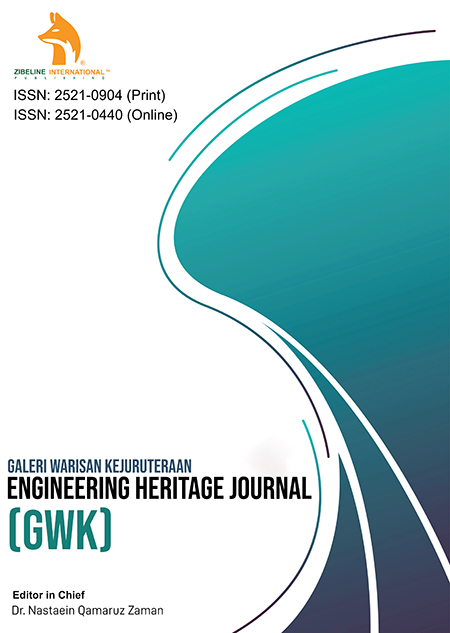ENGINEERING PROPERTIES AND STRENGTH EVALUATION OF SUBSOIL IN EDE NORTH, SOUTHWESTERN NIGERIA: ITS COMPETENCE FOR FOUNDATION PURPOSES
ABSTRACT
ENGINEERING PROPERTIES AND STRENGTH EVALUATION OF SUBSOIL IN EDE NORTH, SOUTHWESTERN NIGERIA: ITS COMPETENCE FOR FOUNDATION PURPOSES
Journal: Engineering Heritage Journal (GWK)
Author: Adekunle Moses Adekeye, Olabode Olabanji Olofinyo, Temitayo Olamide Ale
This is an open access article distributed under the Creative Commons Attribution License CC BY 4.0, which permits unrestricted use, distribution, and reproduction in any medium, provided the original work is properly cited
DOI: 10.26480/gwk.02.2021.58.64
 This research is aimed at examining the strength properties of subsoil at Ede North, Southwestern Nigeria so as to determine its competence as foundation material. A total of 45 soil samples: 30 disturbed samples and 15 undisturbed samples were taken for different tests and analysis. These samples were subjected to laboratory tests of grain size analysis, atterberg limits for the disturbed samples while density, triaxial compression test, permeability, unconfined compression test and odometer consolidation test for the undisturbed samples. The liquid limit of the soil samples at Pit A, Pit B, Pit C, Pit D and Pit E range from 34.57% to 46.20%, 42.43%-48.02%, 40.20%-50.14%, 35.21%-46.04% and 43.04%-47.62% respectively. The plasticity indexes of the soil samples at all pit points range from 16.90%-22.70%. The specific gravity of the subsoil ranges from 2.55 to 2.65. This shows that these sampled soils are either sand or silty sand. The coarse contents of the sampled soil ranges from 33.7% to 61.2% while the fine contents ranges from 38.8% to 66.3%. Samples in pit A fall within the A-7-6 and A-6, samples in pit B and E falls within A-7-6, samples in pit C falls within A-7-6 and A-7-5 while most samples in pit D falls within A-7-6 and A-6. This implies that the soil samples are rated between fair to poor sub-grade materials. They general fall under clayey soils. The coefficient of permeability for the soils ranged from 6.45 × 10-8cm to 1.4 × 10-9cm which classified them as practically impermeable soils. Again, the values of the shear strength parameters are; the angle of internal friction ranged from 11.90 to 37.50, the cohesion ranges from 4.7 kPa to 84.9kPa.
This research is aimed at examining the strength properties of subsoil at Ede North, Southwestern Nigeria so as to determine its competence as foundation material. A total of 45 soil samples: 30 disturbed samples and 15 undisturbed samples were taken for different tests and analysis. These samples were subjected to laboratory tests of grain size analysis, atterberg limits for the disturbed samples while density, triaxial compression test, permeability, unconfined compression test and odometer consolidation test for the undisturbed samples. The liquid limit of the soil samples at Pit A, Pit B, Pit C, Pit D and Pit E range from 34.57% to 46.20%, 42.43%-48.02%, 40.20%-50.14%, 35.21%-46.04% and 43.04%-47.62% respectively. The plasticity indexes of the soil samples at all pit points range from 16.90%-22.70%. The specific gravity of the subsoil ranges from 2.55 to 2.65. This shows that these sampled soils are either sand or silty sand. The coarse contents of the sampled soil ranges from 33.7% to 61.2% while the fine contents ranges from 38.8% to 66.3%. Samples in pit A fall within the A-7-6 and A-6, samples in pit B and E falls within A-7-6, samples in pit C falls within A-7-6 and A-7-5 while most samples in pit D falls within A-7-6 and A-6. This implies that the soil samples are rated between fair to poor sub-grade materials. They general fall under clayey soils. The coefficient of permeability for the soils ranged from 6.45 × 10-8cm to 1.4 × 10-9cm which classified them as practically impermeable soils. Again, the values of the shear strength parameters are; the angle of internal friction ranged from 11.90 to 37.50, the cohesion ranges from 4.7 kPa to 84.9kPa.| Pages | 58-64 |
| Year | 2021 |
| Issue | 2 |
| Volume | 5 |



